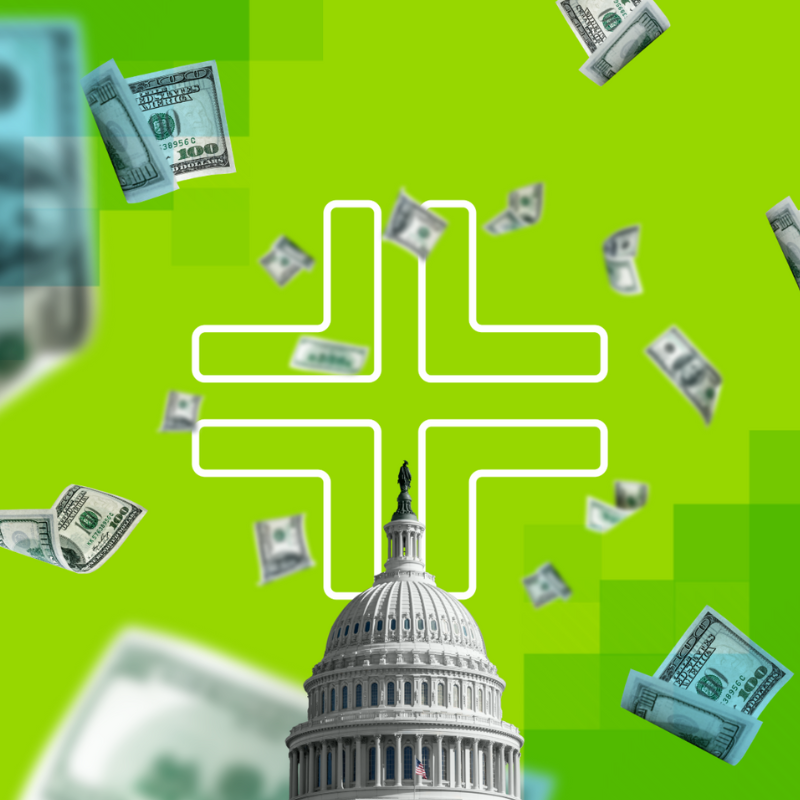President Trump has now signed The Big Beautiful Bill into law. The House passed the Senate’s version of the bill just shy of the president’s July 4 deadline. The broad provisions in the bill impact many areas of taxation, including tax-exempt organizations.
The final version abandons many earlier proposals that alarmed nonprofits, while several key tax changes have been finalized.
Below is a review of the final bill’s provisions (and the fates of those that were pulled) as they relate to exempt organizations and charitable nonprofits.
What Is in the Final Bill?
Broader Excise Tax on High Exempt Organization Salaries
The final bill expands the 21% excise tax on compensation over $1 million (Internal Revenue Code §4960) to all employees of a tax-exempt organization, not just the five highest-paid executives.
Earlier House and Senate versions both contained this expansion. The House’s bill proposed extending the excise tax to all employees (initial drafts even considered including employees of related entities), and the Senate Finance Committee agreed to the same broad coverage.
The final legislation adopts that approach: any staff member of a nonprofit earning over $1 million annually will trigger the 21% excise tax on the excess compensation, effective for tax years beginning after 2025. (Notably, the final bill retains the current rule that only employees after 2016 are counted, and compensation for medical services remains exempt, as under prior law.)
Implications: This change could significantly increase employment costs for organizations with multiple high-paid individuals. With the expansion now law, boards and management may need to revisit executive pay structures or consider deferring compensation to reduce exposure to the excise tax.
Higher Tax on Large University Endowments
The final bill makes sweeping changes to the excise tax on net investment income of certain private colleges and universities (the “endowment tax”).
Under current law (enacted in 2017), affected schools paid a flat 1.4% tax on their net investment income if they had at least 500 students and large endowments. The House’s version of the 2025 bill had proposed steeply graduated rates up to 21% for the wealthiest universities (those with assets over $2 million per student). The Senate’s draft scaled this back to a top rate of 8%, with a tiered structure of 1.4%, 4% and 8% depending on endowment size.
The final legislation adopts the Senate’s more moderate approach of a multi-tiered tax on endowment earnings, with rates of 1.4%, 4% and 8% at the highest tier. The 8% rate will apply to institutions with endowment assets exceeding $2 million per student.
Importantly, the final bill also raises the student threshold for this tax. A university will now need at least 3,000 tuition-paying students (up from 500) to be subject to the endowment tax. This change means many smaller colleges will escape the tax entirely, regardless of endowment size.
Additionally, Congress broadened the base of what counts as taxable investment income for universities. Interest on student loans and certain royalty income (from intellectual property developed with federal funds) will no longer be excluded and will be subject to the excise tax going forward.
The new endowment tax rules will take effect for tax years beginning after December 31, 2025.
Implications: While the final tax on endowments is not as onerous as the House’s originally proposed 21% rate, large private universities will still face higher taxes on their endowment returns (up to 8%, versus 1.4% under prior law). University financial officers should plan for this increase in tax liability, which could divert funds from scholarships, research and operations.
Charitable Giving Modifications
The final tax reform bill contains several provisions that will impact charitable giving by both individuals and corporations.
Permanent Higher Standard Deduction
The final bill permanently extends the larger standard deduction that was set to expire after 2025.
For context, the House had proposed making the Tax Cuts and Jobs Act’s nearly doubled standard deduction permanent (approximately $15,000 single / $30,000 joint for 2025, with an additional temporary boost of $1,000/$2,000 through 2028). The Senate similarly favored permanence, with slightly higher inflation-adjusted values ($16,000 single / $32,000 joint starting in 2026).
The final law locks in a roughly $15,750 standard deduction for single filers and $31,500 for joint filers beginning in 2025 (with inflation indexing).
Effect on Giving: A permanently larger standard deduction means fewer taxpayers will itemize their deductions, and thus fewer will claim charitable contribution deductions. With the threshold for itemizing now so high, many middle-income donors will take the standard deduction and get no tax break for their gifts.
Charities should prepare for reduced tax-driven giving incentives and anticipate that donors will be motivated more by the mission than by tax benefits. Fundraisers may need to emphasize the intrinsic value of donations, and less on the added tax benefit, to sustain support.
New 0.5% Floor on Itemized Deductions
A significant new limitation from the Senate bill has been enacted into the final law: individuals who itemize can only deduct charitable contributions that exceed 0.5% of their adjusted gross income (AGI). This essentially means that the first 0.5% of one’s income given to charity will not be deductible. The House had no such provision in its version of the bill. Now enacted, this floor will apply starting in 2026.
The current 60% AGI limitation for deductions of cash contributions to qualified 501(c)(3) public charities remains in place, with amounts exceeding this threshold carried forward for up to five years.
Effect on Giving: The 0.5% floor may discourage some charitable giving at the margins. Casual donors who give smaller amounts relative to their income could find that those gifts no longer yield a deduction, potentially dampening their incentive to donate.
As with the higher standard deduction, this change could reduce overall donations, making it even more critical for nonprofits to highlight the impact of their work.
Above-the-Line Deduction for Nonitemizers
In a win for the charitable sector, the final bill reinstates and significantly expands the charitable deduction for taxpayers who do not itemize.
The House’s bill proposed reinstating the expired “above-the-line” charity deduction, but only through 2028, and capped it at $150 for singles ($300 for joint filers) per year. The Senate countered with a more generous, permanent deduction of $1,000 for singles ($2,000 joint).
The final law adopts the Senate’s approach, nonitemizers can deduct up to $1,000 (single) or $2,000 (joint) in cash donations each year, permanently.
Effect on Giving: This universal charitable deduction, now six times larger than the temporary version in 2020/2021, could encourage more people to give, even if they do not itemize. Nonprofits may see an expanded base of small and mid-level donors taking advantage of the deduction.
By substantially raising the cap and making it permanent, Congress aims to incentivize charitable giving across a broader segment of taxpayers. Charitable organizations should leverage this by promoting the above-the-line deduction in appeals, potentially boosting the volume of modest donations.
1% Floor for Corporate Charitable Deductions
The final bill imposes a new requirement that businesses donate at least 1% of their taxable income for their charitable contributions to be deductible. Both the House and Senate had agreed on this corporate giving floor from the start.
The final legislation not only includes the 1% threshold but also adds new restrictions on carrying forward charitable deductions that do not meet the floor. In practice, a corporation must now give at least 1% of its income to get any deduction; if it gives less, none of the contribution is deductible.
The longstanding 10% of income ceiling on corporate charitable deductions remains in place; amounts above 10% are still non-deductible, with a carryforward for excess contributions.
Effect on Giving: This provision could particularly affect companies that make small charitable gifts relative to their income. Corporate donors will need to give at least 1% of earnings to benefit from the deduction, which may encourage some to increase giving to meet the threshold or, conversely, discourage token donations that fall below it.
Nonprofits that rely on corporate philanthropy or sponsorships should be aware of this rule in discussions with giving partners and can encourage corporate donors to commit at least 1% of their profits to charity, ensuring that their contributions remain deductible.
This floor effectively sets a benchmark for corporate goodwill. Companies near the line may boost giving to clear the 1% threshold, potentially benefiting charities, while very low-margin firms might curtail deductible giving if they cannot afford to reach the 1% level.
Get the Latest Tax and Legislative Developments
Withum’s National Tax Policy and Legislative Updates Resource Center is your go-to source for timely updates on tax law and legislative changes. Our team is closely monitoring sweeping tax reform changes, shifting tariffs and tax industry updates, delivering in-depth analysis and actionable insights.
What Was Excluded from the Final Bill?
Congress considered, but in the end omitted, a few provisions that would have broadened the scope of taxable Unrelated Business Income (“UBIT”) for nonprofits and increased excise tax on Private Foundations:
- Tax on Employee Fringe Benefits (“Parking Tax”): The House’s bill would have reinstated the tax on certain employer-provided fringe benefits by treating expenses for employee parking and transit passes as taxable unrelated business income (essentially reviving the controversial 2017 “parking tax,” with an exemption for churches). The Senate Finance Committee removed this proposal entirely in its version, and the final negotiated bill did not include any tax on transportation fringes. This means nonprofits will not be taxed on the parking facilities or transit benefits they provide to employees, preserving the status quo established when the original parking tax was repealed in 2019.
- Limiting the Research Exemption: The House also sought to clarify that income from scientific research by a nonprofit would be tax-exempt only if the results are made freely available to the public. Under that proposal, if a tax-exempt organization performed research under agreements that restrict public dissemination (e.g., proprietary research or contract research for private clients), the income would be treated as unrelated business taxable income. The Senate chose not to include this limitation, and it did not surface in the final bill. Thus, the traditional research exemption remains intact, and nonprofits can continue to exclude research income from UBI even if the research is not publicly released (as per current law).
- UBI on Name and Logo Royalties: Lawmakers briefly considered taxing a nonprofit’s royalty income from licensing its name, logo or trademark. The original House draft of the bill contained such a provision treating name and logo royalties as unrelated business taxable income. However, due to significant pushback, this was removed during House committee markup and never made it to the House-passed version. The Senate did not reinstate it, and the final bill does not include any changes; royalty income from a tax-exempt organization’s trademarks and logos will continue to be exempt from UBIT.
- No Change to Private Foundation Investment Tax: The House’s tax bill sought to replace the flat 1.39% excise tax on private foundation net investment income with a graduated rate system, imposing higher taxes on larger foundations (tiers of 1.39%, 2.78%, 5% and 10% based on the foundation’s asset size). This would have dramatically increased tax burdens on the investment income of the biggest private foundations. The Senate struck this provision from its version, opting to leave the private foundation excise tax at the current single rate. In the final bill, the Senate's position prevailed, and no changes were made to the private foundation excise tax. Foundations will continue to pay a flat 1.39% on their net investment income, as under existing law.
Other Abandoned Provisions
Expanded IRS Authority to Revoke Exempt Status (“Terrorist Support” Provision): Lawmakers eliminated the measure that would have given the Treasury Department power to swiftly revoke a nonprofit’s tax-exempt status if it is labeled as a “terrorist-supporting” organization. This provision was stripped from the House bill before passage, and the Senate neither added it nor included it in the final bill.
Outlook and Next Steps
The final tax reform bill of 2025 brings a mixed bag of new burdens and new opportunities for tax-exempt organizations.
On one hand, nonprofits will face stricter taxes on executive pay and university endowments, and some charitable deductions will be harder for donors to claim (due to the higher standard deduction and itemized deduction floor).
On the other hand, the sector avoided several potential hits as there will be no tax on fringe benefits, research or royalties, and private foundations dodged a major tax increase. Moreover, charitable organizations can celebrate the return (and enhancement) of the universal charitable deduction for nonitemizers, which may stimulate broader giving.
Proactive planning, from budgeting for potential excise taxes to rethinking fundraising tactics, will be essential. As always, Withum’s Not-for-Profit and Education Services Team is available to help organizations navigate these tax law changes and adapt effectively in the post-reform landscape.
Contact Us
For more information on this topic, please contact a member of Withum’s Not-For-Profit and Education Services Team.





